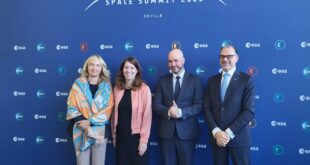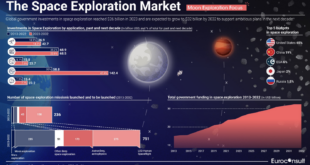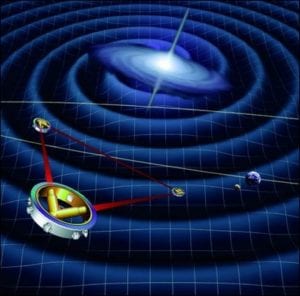
Like all waves, gravitational ones transport energy, producing perturbations. We can visualize them by imagining a rope which we hold at one end and is tightly fixed on the other one; when we give a vertical impulse to it, we produce a perturbation — a “wave” — that propagates forward to the other end.
The rope is like the spacetime “fabric,” the gravitational waves can be imagined as the perturbations produced to the spacetime fabric by certain space objects, quadrupoles of gravitational mass, for example binary systems of orbiting space objects or non-spherical heavy bodies (like black holes, neutron stars, supernova, etc.). Like electromagnetic waves in empty space, the gravitational ones propagate at the speed of light and require very sensitive instruments capable of detecting perturbations of the order of magnitude of 10-12 m on 2.5 * 109 m.
Since they were first predicted, scientists have been working on the detection and relevant data analysis of gravitational waves. One of these scientists is Professor Catia Grimani, Associate Professor at the University of Urbino Carlo Bo in Italy.
Professor Catia Grimani’s main scientific interests are the search for antimatter in primary cosmic rays, the study of primary and secondary cosmic-ray fluxes with balloon-borne magnetic spectrometer experiments, and the environmental study of the effects of high-energy particles limiting the performance of space instruments in terms of both dose absorption and loss of efficiency.
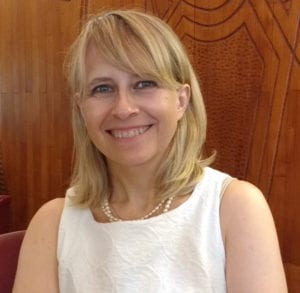
She is a core team member of the European Space Agency’s (ESA) Laser Interferometer Space Antenna (LISA) Pathfinder and LISA missions. Since 2003 she is responsible of the LISA Pathfinder and LISA research group of the Italian Institute for Nuclear Physics Section in Florence. She also manages the University of Urbino’s team that participates in the LISA Consortium, whose work was awarded the ESA Corporate Team Achievement Award in 2016 and the American Astronautical Society’s Space Technology Award in 2017.
SpaceWatch Global’s Tiziana Casinelli had the opportunity to interview Prof. Grimani about this important scientific research.
Professor Grimani, why are gravitational waves so important for science?
Gravitational waves were formally predicted by Albert Einstein in 1915, they were first detected at the end of 2015 by the LIGO-Virgo collaboration with Earth detectors (laser interferometers). Their importance for science is multifaced and their detection has been crucial to prove Einstein’s intuition that gravity cannot be described by Newton’s force alone, but through the distortion of the spacetime fabric produced by large masses, like a hippopotamus sitting on a mattress.
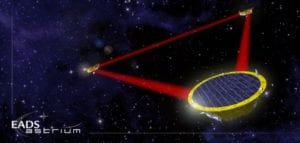
What are the goals of the Laser Interferometer Space Antenna (LISA) Pathfinder and LISA missions, and how are they linked with each other?
Both LISA Pathfinder and LISA are European Space Agency missions, with NASA as a junior partner. LISA Pathfinder was launched on 3 December 2015 and terminated on 18 July 2017. The mission orbited around the Lagrange point L1, at a distance of 1.5 million km from Earth.
It was designed to test the technology that will be placed on LISA, the first interferometer for low-frequency gravitational wave detection in space. It was also expected to provide important data and measurements for science — and particularly for the LISA mission, which is expected to be launched in 15 years. The LISA Pathfinder mission also provided ancillary but important clues on the interplanetary medium characteristics that will find applications in space weather.
The technology onboard the LISA spacecraft will be able to detect the passage of gravitational waves. This will be achieved by measuring the motion of two gold-platinum cubic masses placed on each spacecraft, maintained in a perfect free-fall state. The spacecraft will be positioned at a distance of 2.5 million kilometers from each other. Those test masses play the role of mirrors of the laser beams emitted from neighboring spacecraft; the “mirrors” will move at the passage of any gravitational waves but also due to other type of perturbations (noise).
LISA Pathfinder’s main goal was helping to identify all types of noise, to define above which threshold the motions of the test masses are due to gravitational waves. This information is required to build technology able to measure the acceleration of a mass in a perfect vacuum at a femtog accuracy (10-15 g, gravity acceleration on Earth), which means measuring the effect of a virus accelerating a mass in free fall state.
What is the role of Urbino University in these missions?
LISA missions’ collaborative team wants to detect gravitational wave transits, and distinguish them from the noise produced by spurious forces: this is the framework of the Urbino group. We work on identifying the space environmental events that could limit the efficiencies of the space interferometers, and which could perturbate the test masses in free fall. We study the disturbances that produce charged high-energy particles of galactic and solar origin penetrating the spacecraft and stopping in the test masses, resulting in one source of noise.
How is the LISA Pathfinder team composed?
The LISA Pathfinder collaboration consisted of fewer than 70 people. Groups from Italy, Germany, United Kingdom, France, Switzerland, Spain, the Netherlands, and one US group formed the collaboration. Urbino University contributed three experts to this team.
What is the status of the LISA Pathfinder mission?
LISA Pathfinder was a very successful mission, which almost completely accomplished its goals. The mission terminated on 18 July 2017.
It is worth mentioning that, in addition to the major achievements, the scientific collaboration obtained an accurate measurement of the universal gravitational constant, measured the dose and effects of low-energy electrons emitted at the separation of metallic surfaces hit by cosmic rays, and, last but not least, permitted us to catalog the meteoroid masses in L1 orbit.
The mission was definitely a great success for science!
Thanks to those results you are now making great progress on the LISA mission. Who is in this team?
LISA consists of a core team which basically corresponds to the core team of LISA Pathfinder. There is also a Consortium consisting of about 1200 scientists working on LISA science. They will be the main users of the mission data.
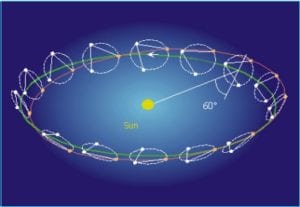
What is the status of the LISA project, and what do you expect to achieve from the mission?
The LISA spacecraft will take off with the same launcher in 2034. The mission is undergoing its phase A development, which aims to finalize the procurement process of all its components. It will take approximately one year for the constellation to reach its final orbit, and it will have a mission lifetime of four to six years.
As you wait for the LISA mission, what existing experiments are being used to detect gravitational waves?
The main Earth-based detectors to catch gravitational waves are the two US interferometers LIGO and the Italian interferometer VIRGO; others are under construction and undergoing optimization in Japan, India, and Australia. Those experiments permit us to detect waves above a certain frequency (about 1 Hz), while the LISA space-based experiments will allow us to detect events below that threshold.
Also, with LISA in operation, a multi-band astronomy between space-based and ground-based interferometers will be possible with the same astrophysical sources. For example, the inspiral phase of stellar black-hole binaries will be measured by LISA for years, while the ground detectors will be able to detect the coalescence of the same systems for only one minute, but scientists will be able to complement that data with LISA data and carry out more precise analysis to test the hyposthesis of gravitational waves.
SpaceWatch.Global thanks Professor Catia Grimani from University of Urbino for the interview.



